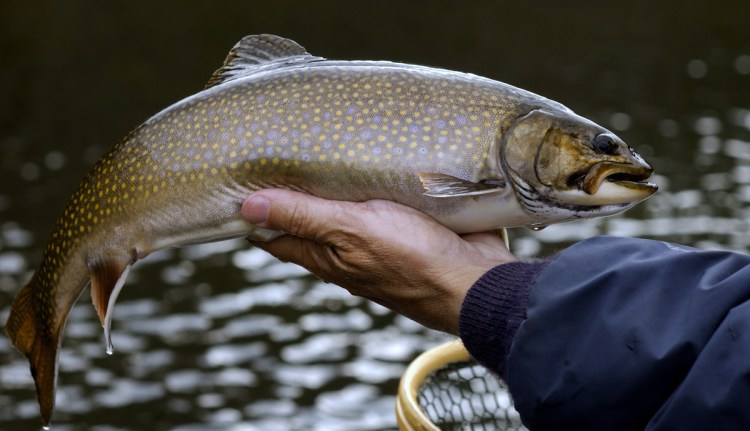Maine is considering a new regulation that would make fishing with live fish as bait the exception rather than the general law in most of northern Maine, as it is now. State biologists say the new regulation, if brought forward, would help better protect the wild trout waters in northern Maine, which represent the majority of wild brook trout waters in the Northeast.
However, while trout fishermen think the concept is a good way to better protect Maine’s valuable wild trout populations, they hope the state pursues the new regulation in a way that draws buy-in from fishermen.
“It’s a good step forward, but it needs to be approached in the right manner. I think a lot of places where older folks are fishing the way they like to fish for decades, I think if the proposal is pushed forward too heavy-handed, there could be push back. That worries me,” said Jen Brophy, owner of Red River Camps in the North Maine Woods.
At Red River Camps in the pristine Deboullie Public Reserved Land, Brophy’s livelihood is based on the rare wild trout waters, so she favors better protection for the native brook trout and Arctic char populations, which date back to the Ice Age.
Several states away along the North Carolina coast, trout fisherman Lowell Mason, who has traveled to Maine to fish for the rare char, agreed. Mason said such a rule is imperative but should be implemented wisely.
“If you’re trying to save the resource, you need to put it out there the reasons why you’re doing it. I hate to shut people out,” Mason said. “You have to save the resource – but do it in a good way. There needs to be public outreach explaining why it’s needed. The people who live off the land and live on the outskirts who are used to going to their fishing hole and dropping (a smelt) in and catching dinner, it’s a big change for the locals.”
Maine Director of Fisheries biologist Francis Brautigam said biologists with the Department of Inland Fisheries and Wildlife have no intention of shutting out the common fishermen who come from a tradition of casting with smelts or other live bait.
A rule has not yet been drafted, and the state doesn’t have a list of waters that would be affected.
State biologists held an information meeting in Augusta on Wednesday to hear what fishermen had to say. A second meeting will be held at 6:30 p.m. this Wednesday at IFW Headquarters in Ashland.
Currently, the use of live fish as bait is allowed unless there are bodies of water exempted by special regulations. Brautigam said the department would like to reverse that and minimize the places where live fish can be used as bait in northern counties, where there’s an abundance of wild brook trout and Arctic char.
The counties that would be affected are in IFW’s northern management zone, which includes Aroostook, Penobscot north of routes 11 and 157, Piscataquis, Somerset, Franklin and Oxford north of the Androscoggin River.
Brautigam said the first step is to gauge public feeling.
“Our goal is to find a balance,” Brautigam said. “I think this strategy is very sensitive to the traditional anglers who like to fish with live bait fish. We will identify waters where they can continue to fish with live fish as bait. I believe their concerns will be addressed in any proposed rule.”
When live bait fish are put into or escape into wild trout waters, the smaller fish compete with the wild trout for forage and threaten these fisheries. In some instances, non-native bait fish have hurt wild populations, such as Big Reed Pond in the North Maine Woods where the state had to reclaim the Arctic char fishery.
The ultimate goal of a new regulation, Brautigam said, would be to shift public perception so that there’s a more widespread understanding that wild brook trout waters need protection.
Maine is home to 97 percent of native wild brook trout lake and pond populations in the eastern United States, according to a 2006 report by a consortium of state and federal agencies and Trout Unlimited.
About 10 percent of Maine’s 6,000 lakes and ponds, or 578 at last count, hold wild and native brook trout, according to IFW.
By comparison, New Hampshire has only three wild trout ponds, said Jeff Reardon, the Maine director for Trout Unlimited.
Reardon called the proposal a big step forward because it questions a widespread assumption that using live bait fish is safe, and it puts a greater focus of the importance of Maine’s wild trout fisheries.
“The general assumption in Maine is that live fish as bait today don’t pose any risk, that everything is open to it unless it’s closed, and it’s only closed if it’s been assessed,” Reardon said. “This would turn that around. The other thing is there are a lot of small waters where (fishing with) live fish as bait is probably very uncommon because they’re remote. But if live bait fish got to those places, it could do harm. Under this concept, those waters will all end up being protected.”
Mason said in the mountains of North Carolina where there are wild trout fisheries, the law mostly forbids live fish as bait, and in a place like Maine with such a rich resource, more stringent regulations are overdue.
“You need to keep those waters as clean as you can,” Mason said. “It’s a special resource, one we don’t have anywhere else in the United States.”
Send questions/comments to the editors.




Comments are no longer available on this story